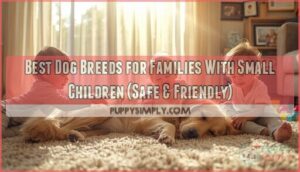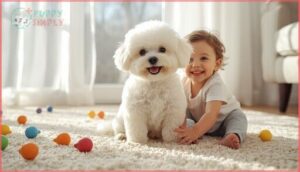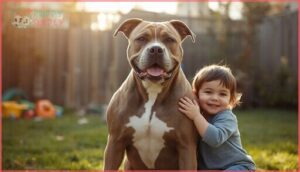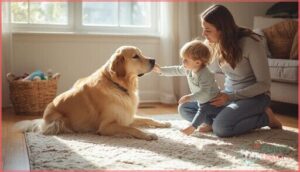This site is supported by our readers. We may earn a commission, at no cost to you, if you purchase through links.
You picture it clearly: tiny hands reaching for soft fur, giggles erupting as a wet nose nuzzles a toddler’s cheek, and the deep peace that comes from knowing your child has a loyal companion. But behind every heartwarming scene is a vital decision—choosing a dog breed that won’t just tolerate your kids, but genuinely thrive alongside them.
The wrong match can lead to stress, nipped fingers, and heartbreak for everyone involved. Research shows that 82% of positive interactions happen when dogs naturally handle the chaos of childhood: the sudden squeals, the unpredictable movements, the sticky fingers that grab without warning.
Finding dog breeds for families with small children isn’t about picking the cutest face—it’s about understanding temperament, energy levels, and which personalities mesh beautifully with your household’s rhythm.
Table Of Contents
- Key Takeaways
- Key Traits of Family-Friendly Dog Breeds
- Top Small Dog Breeds for Families
- Hypoallergenic and Low-Shedding Breeds
- Choosing a Breed Based on Lifestyle
- Safety and Socialization Tips for Kids and Dogs
- Frequently Asked Questions (FAQs)
- What is the best dog to have with small children?
- What is the most child friendly dog breed?
- What’s the best small family dog?
- How old should children be to get a dog?
- Are hypoallergenic breeds suitable for families with allergies?
- How to introduce a new dog to existing pets?
- What are the financial costs of owning a family dog?
- What age should children be before getting a dog?
- How do I introduce a new dog to my toddler?
- Are rescue dogs safe for families with small children?
- Conclusion
Key Takeaways
- Choose breeds with proven patience and gentle temperaments like Cavalier King Charles Spaniels, Beagles, or Bichon Frises, since 82% of positive child-dog interactions happen when dogs naturally tolerate kids’ unpredictable movements and noise.
- Match your dog’s energy level to your family’s rhythm—high-energy Beagles need 60–90 minutes of daily exercise while calmer Cavaliers thrive with just 30–60 minutes, preventing frustration for both dog and family.
- Prioritize early socialization within the first three months and teach your kids to read dog body language, as proper training reduces fear-based aggression by 50% and children who recognize warning signs make 40% fewer risky moves.
- Never leave dogs and young children unsupervised, since 82% of child-dog injuries occur during unwatched moments—consistent household rules like “no hugging during meals” and constant parental oversight are non-negotiable for safety.
Key Traits of Family-Friendly Dog Breeds
Not every dog is cut out for life with little ones. Some breeds naturally have the patience, resilience, and gentle nature that make them safer and more enjoyable companions for your kids.
Let’s look at the key traits that separate the truly family-friendly breeds from those that might need a quieter home.
Temperament and Patience With Children
The right temperament makes all the difference when you’re bringing a dog into a home with little ones. Look for breeds with gentle natures and calm temperaments—research shows 82% of positive interactions happen when dogs naturally tolerate children’s noise and quick movements. Kid-friendly dogs display patience, not reactivity.
Early patience training builds that tolerance, helping family-friendly dogs thrive alongside your kids. Understanding research networks is essential for developing effective training methods.
Energy Levels and Playfulness
Beyond a calm demeanor, you’ll want to match your family’s rhythm. Beagles bring high energy—think 60–90 minutes of daily exercise needs—while Cavalier King Charles Spaniels settle in with just 30–60. Playful breed traits matter, too:
- Beagles thrive on scent-driven games and outdoor adventures
- Pugs enjoy short bursts of interactive play
- Boston Terriers love quick, animated sessions with puzzle toys
- Shih Tzus prefer gentle, social playtime indoors
Energy level management keeps everyone happy and safe. Understanding main topic branches is essential for organizing information about dog breeds.
Trainability and Obedience
A dog that listens can be a key factor when kids are in the mix. Positive reinforcement training creates obedience training success—dogs trained this way hit 92% task completion after just eight weeks.
Small Dogs for Kids like Cavalier King Charles Spaniels and Boston Terriers respond beautifully to reward systems, learning canine communication faster.
Family-Friendly Dogs with strong trainability make behavioral modification smoother, helping Dog Behavior and Socialization thrive in busy households.
Health, Lifespan, and Maintenance Needs
Training matters, but so does long-term wellness. Beagles live 12–15 years; Cavaliers average 9–14 but face mitral valve disease in 20% by age five. Shih Tzus can reach 18 with proper dental care, while Pugs need respiratory monitoring.
Annual Veterinary Care and weight management reduce Dog Health and Wellness issues by up to 25%, keeping Maintenance Costs predictable and your Small Dog Breeds for Families thriving alongside your kids.
Top Small Dog Breeds for Families
Finding a small dog that fits seamlessly into family life means looking for breeds that truly enjoy being around kids. Some dogs naturally have the patience, playfulness, and gentle nature that make them ideal companions for your little ones.
Here are eight small breeds that consistently show up as safe, friendly choices for families with young children.
Beagle
If you’re picturing a tail-wagging buddy who’ll grow up alongside your kids, the Beagle checks every box. Weighing in at 20–40 pounds, these gentle hounds bring sturdy playfulness without overwhelming little ones.
Here’s why Beagles shine in family dynamics:
- Even-tempered patience during toddler chaos
- Sociable nature that welcomes neighborhood playdates
- Moderate energy perfect for backyard adventures
- Low-maintenance grooming for busy parents
- Strong breed history as loyal family companions
With proper Beagle training and Pet Safety practices, you’re setting up canine behavior success. They’re consistently ranked among the Best Small Dogs and top Dog Breeds for Children—FamilyFriendly Dogs that adapt beautifully to your household rhythm. Just remember: supervision keeps everyone safe while your Small Dogs for Kids learn boundaries together.
Pug
That signature wrinkly face isn’t just adorable—it signals a goofy, sociable personality that thrives on kid energy. Pugs usually stay under 25 pounds, making them manageable for family life without sacrificing sturdiness.
They’re consistently ranked among the Best Small Dogs and top Dog Breeds for Children.
With basic Pug Training, sensible Pug Nutrition, and moderate Pug Exercise, these FamilyFriendly Dogs become loyal Small Dogs for Kids who want constant companionship.
Cavalier King Charles Spaniel
Weighing just 13 to 18 pounds, the Cavalier King Charles Spaniel charms with a gentle nature and friendly temperament that makes them star family companions.
Their royal origins bred patience into every fiber, so they’re exceptionally safe around families with kids.
Basic attention to Spaniel health keeps these best small dogs thriving for 12-plus years, earning their reputation as truly kid-friendly dogs and family-friendly pets.
Boston Terrier
Known for their tuxedo-patterned coats and endearing personalities, Boston Terriers bring playful energy to families with kids while rarely tipping the scale past 25 pounds. Boston Training responds beautifully to positive reinforcement, making them excellent kid-friendly dogs.
Consider these family strengths:
- Playful yet tolerant temperament with children
- Manageable Terrier Nutrition and Dog Exercise needs
- Simple Pet Grooming with minimal shedding
- Sociable nature suits busy households
- Breed History as “American Gentleman” reflects their easygoing charm
Bichon Frise
If you want a gentle cloud of affection that matches your family’s rhythm, the Bichon Frise checks every box. These Kid-Friendly Dogs weigh 12–18 pounds and thrive with Families with Kids, offering hypoallergenic coats and playful patience.
Frise Training responds well to positive methods, while Bichon Grooming—though regular—keeps shedding minimal. Prioritize Bichon Health screenings and balanced Dog Nutrition for a long, joyful partnership in Pet Care.
French Bulldog
French Bulldogs pack charm into 16–28 pounds, making them FamilyFriendly Pets with a playful French Temperament that children adore. Their sociable nature shines in KidFriendly Dogs lists.
While these dogs are ChildFriendly Pets that bring laughter and affection to your home, you’ll need to stay on top of Bulldog Care. Respiratory concerns and heat sensitivity require vigilance. Pet Insurance helps cover breed-specific issues. With proper supervision, these pets thrive in family settings.
Shih Tzu
If you’re drawn to a smaller companion, Shih Tzus bring outgoing charm to FamilyFriendly Pets in a 9–16 pound package. These ChildFriendly Pets show friendly patience with kids, though their delicate build means younger toddlers need gentle handling.
Shih Tzu Grooming demands daily brushing, while Shih Tzu Training and early socialization help your Small Dog Breeds for Families thrive.
Consider these points:
- Shih Tzu Exercise needs stay modest—short walks work well
- Shih Tzu Health requires regular vet checkups for eyes and breathing
- Shih Tzu Nutrition sustains their compact frame and energy levels
Staffordshire Bull Terrier
Beyond those toy breeds, you’ll find the Staffordshire Bull Terrier—a muscular 24–38 pound companion whose breed history traces back to working-class England. Despite their powerful build, these gentle dog breeds for children display affectionate loyalty when socialized early. Their exercise needs run high, making them ideal for active family pets and children who love outdoor play.
Dog breeds suitable for children like Staffies thrive when you combine structured training with plenty of supervised family time.
| Care Factor | Staffordshire Bull Terrier |
|---|---|
| Training Methods | Positive reinforcement works best |
| Dog Nutrition | High-protein diet for muscle health |
| ChildDog Interaction | Supervision required with toddlers |
| Pet Insurance | Consider coverage for joint issues |
| KidFriendly Animals | Excellent with proper socialization |
Hypoallergenic and Low-Shedding Breeds
If allergies are a concern in your household, you’ll be relieved to know that several small dog breeds shed minimally and produce less dander. These hypoallergenic options can help keep sneezing and itching at bay while still bringing all the warmth and companionship your family wants.
Here are some top low-shedding breeds that work beautifully with kids.
Maltese
If you’re looking for a gentle companion with minimal shedding, the Maltese checks both boxes. Their low-shedding coat appeals to families with allergy concerns—about 58% of dog owners report better symptom control with hypoallergenic small dog breeds.
Maltese grooming involves weekly brushing to prevent matting, and Maltese training responds well to positive reinforcement.
With proper canine behavior guidance, dog nutrition, and pet insurance coverage, this kid-friendly animal becomes an ideal family pet planning choice.
Miniature Schnauzer
Miniature Schnauzers bring a spirited personality and low-shedding coat to families juggling allergy concerns. Their breed history as farm dogs gives them resilience around active kids. With Schnauzer Training rooted in positive reinforcement, they adapt quickly to family dynamics and child-pet interactions.
Miniature Grooming requires weekly brushing, while health concerns like dental issues affect 15–25% of small dog breeds—regular vet visits keep them thriving.
Poodle
Poodles excel as family pets because their tightly curled coat reduces shedding by up to 85%, making them perfect child-friendly dogs for households with allergies. Here’s what makes them ideal dog breeds for families in pet-friendly living:
- Poodle Training thrives on positive reinforcement—they master obedience in 6–12 weeks
- Poodle Grooming needs weekly brushing plus monthly professional sessions
- Poodle Health benefits from regular vet checkups and dental care
- Poodle Nutrition sustains their 12–15 year lifespan
- Poodle Exercise requires 40–60 minutes daily
Their intelligence and gentle nature make them wonderful around kids.
Soft-Coated Wheaten Terrier
Soft-Coated Wheaten Terriers bring hypoallergenic coats and steady temperaments to family pets—their single-layer fur sheds minimally, easing allergy concerns while their playful energy matches active households.
Training Tips emphasize gentle consistency: they respond beautifully to positive reinforcement, mastering basics in weeks.
Grooming Needs include weekly brushing to prevent tangles. Health Issues like protein-losing conditions require vet monitoring, but with proper Pet Safety and Wellbeing care, these child-friendly dogs thrive alongside kids for 12–15 years.
Havanese
Havanese bring playful intelligence and hypoallergenic coats to Family Dogs—their low-shedding fur cuts allergen exposure while their gentle nature makes them outstanding ChildFriendly Dogs.
Havanese Training rewards patience, with positive reinforcement yielding obedience in weeks. Havanese Grooming demands daily brushing to prevent mats. Havanese Exercise needs stay moderate—40–60 minutes daily keeps them happy.
Havanese Health and Havanese Nutrition focus prevents dental issues, ensuring these Small Dog Breeds for Families thrive through safe ChildPet Interactions for 12–15 years.
Yorkshire Terrier
Yorkshire Terriers, with their spunk and affectionate loyalty, make standout Child-Friendly Dogs. Their low-shedding coat reduces allergens, while their bold personality delights families.
Yorkie care and terrier training thrive on consistency:
- Daily brushing prevents tangles in their silky coat
- Positive reinforcement builds confidence during Pet Grooming Tips sessions
- 30-minute Dog Exercise Needs keep these Small Dog Breeds for Families engaged
Small Dog Nutrition and gentle Child-Pet Interactions support Family Dogs through 12–15 healthy years.
Choosing a Breed Based on Lifestyle
Your home, schedule, and daily rhythm all shape which dog will thrive in your family. A breed that’s perfect for one household might feel stressed or under-stimulated in another.
Let’s look at how different breeds match up with common living situations and family lifestyles.
Apartment-Friendly Small Breeds
Compact living doesn’t mean compromising on family-friendly dogs. Beagles (20-25 pounds), Pugs (14-18 pounds), and Cavalier King Charles Spaniels (13-18 pounds) thrive in apartments with daily walks and indoor enrichment. These small dog breeds for families manage noise levels well and adapt beautifully to space efficiency challenges.
Boston Terriers and Shih Tzus also excel as apartment dogs when you maintain consistent routines and consider pet insurance for urban canines.
Breeds for Active Households
If your family moves at full speed, Beagles and Cavalier King Charles Spaniels match that energy with daily exercise needs exceeding 15 minutes—think backyard fetch or trail walks. Boston Terriers thrive on interactive games, while Staffordshire Bull Terriers bring loyalty and stamina to family fitness routines.
These intelligent dog breeds for active families adapt beautifully to busy schedules when you prioritize pet-friendly activities and structured play.
Dogs for Families With Allergy Concerns
If allergies worry you, Maltese and Miniature Schnauzers produce less pet dander—studies show up to 60% lower allergen levels in non-shedding breeds. Poodles and Bichon Frises suit family-friendly pets with hypoallergenic traits, though individual reactions vary widely.
Combine breed selection with HEPA filters and regular grooming for the best results. Consider allergy testing and trial periods before committing to small dog breeds for apartments or pet-friendly living arrangements.
Breeds Requiring Minimal Grooming
Beyond allergy concerns, grooming time matters when you’re juggling family dynamics and pet care. Beagles and Boston Terriers need brushing just once or twice weekly—perfect for dog breeds for busy families. Cavaliers require moderate upkeep, while Shih Tzus demand daily brushing despite their popularity.
For truly low-maintenance dog care, short-coated gentle dog breeds let you focus on playtime instead of constant trimming.
Safety and Socialization Tips for Kids and Dogs
Bringing a dog into your family isn’t just about picking the right breed—it’s about creating a safe, happy environment where kids and dogs can thrive together. You’ll need to teach both your children and your new pup how to interact respectfully, set clear boundaries from day one, and stay alert to potential health or behavior issues before they become problems.
Here’s how to build that foundation of safety and trust in your home.
Early Socialization and Training
Start puppy socialization within the first three months—dogs introduced early to diverse environments and people show 50% less fear-based aggression later.
Positive, reward-based training methods starting before 16 weeks boost long-term dog obedience by 28% compared to harsh techniques.
Short, consistent family training sessions improve canine behavior and strengthen family dynamics, reducing child and dog interaction risks by helping your pet master recall and impulse control.
Teaching Children Safe Dog Interaction
Your dog can’t learn impulse control without help—and neither can your kids. Teaching children safe dog interaction means showing them how to read canine communication like tail position and ear placement. Kids who recognize warning signs make 40% fewer risky moves.
Here are three key strategies to teach children safe dog interaction:
- Respect dog body language: Teach children that stiff postures, pinned ears, or growling mean “back off now.”
- Practice gentle touch: Show kids where to pet—back and under chin—not the face or tail.
- Use calm greetings: Slow, quiet approaches prevent startled reactions and build trust between child and dog.
When children understand these safe play rules, you’re building family safety tips that protect everyone. Child education on dog safety and training isn’t optional—it’s how you prevent the scared nip or accidental bite. Even small dog breeds need respect, and kids who learn proper child and dog interactions create happier homes for years ahead.
Supervision and Setting Boundaries
Honestly, most incidents happen when nobody’s watching. Around 82% of child-dog injuries occur during unsupervised moments, so Parental Involvement isn’t optional—it’s essential for Child Safety.
Most child-dog injuries happen during unsupervised moments, making constant parental oversight essential for safety
Write down Household Guidelines like “no hugging during meals” and “always ask before petting,” then enforce them consistently. These Boundary Rules and Supervision Tips shape safe Child and Dog Interactions, turning Family Pet Care into a daily habit that protects your Family Friendly Pets.
Reducing Health and Behavior Risks
Regular Health Monitoring and early Behavioral Therapy catch problems before they escalate. Structured play—just five minutes daily—cuts conflict events by 15%, while teaching your kids Dog Safety Tips before first introductions lowers injury risk by 64%.
Vet visits, positive training, and constant Risk Assessment form your Accident Prevention toolkit.
When you choose calm Small Dog Breeds and commit to Pet Safety routines, you’re building lasting Family Pet Care habits that protect everyone.
Frequently Asked Questions (FAQs)
What is the best dog to have with small children?
Picture a toddler’s delighted squeal when a gentle pup nuzzles closer—that’s the magic of choosing breeds like Cavalier King Charles Spaniels, Beagles, or Bichon Frises, known for patience, playfulness, and proven family-friendly temperaments.
What is the most child friendly dog breed?
When you’re weighing breed comparison and pet compatibility, Beagles and Cavalier King Charles Spaniels consistently lead in child safety and dog temperament.
Both balance playfulness with patience, earning top marks in family dynamics research.
What’s the best small family dog?
There’s no single “best” option—Cavalier King Charles Spaniels, Beagles, and Bichon Frises consistently rank high for gentle temperaments and child safety.
Your family’s lifestyle, space, and activity level ultimately determine the perfect match.
How old should children be to get a dog?
Like choosing the right time for a first bike, timing a family dog matters. Most experts recommend waiting until your child reaches age five—when impulse control, empathy, and safety awareness align for successful family readiness.
Are hypoallergenic breeds suitable for families with allergies?
Hypoallergenic breeds can help some families with allergies, but they’re not guaranteed solutions. About 10–15% of people experience fewer symptoms with low-shedding breeds.
Allergy testing and allergen reduction strategies matter more than breed selection alone.
How to introduce a new dog to existing pets?
Start on neutral territory, like a park, then gradually introduce your new dog at home using separate spaces and baby gates.
Keep early meetings short, supervised, and reward calm behavior with treats to build positive associations.
What are the financial costs of owning a family dog?
Ever wonder what that adorable pup really costs? First-year expenses run $1,500–$4,000 covering initial costs and veterinary care, while ongoing expenses average $1,000–$1,500 annually for responsible pet ownership in pet-friendly homes.
What age should children be before getting a dog?
Most families find that waiting until children reach 4–6 years old works best. At this age, kids can follow safety rules consistently, understand gentle handling, and participate meaningfully in supervised pet care routines.
How do I introduce a new dog to my toddler?
Picture a quiet corner where your new pup sniffs a favorite blanket while your toddler watches from a safe distance.
Slow, supervised introductions on neutral ground—letting your dog approach first—build trust and reduce stress for everyone involved.
Are rescue dogs safe for families with small children?
Yes, rescue dogs can be safe family pets when properly matched through foster care assessments. Shelters reporting 60–70% successful integrations rely on behavioral support, structured adoption processes, and ongoing post-adoption training to guarantee family-friendly outcomes.
Conclusion
Think of your family dog as a bridge—connecting childhood wonder to lifelong lessons in empathy, responsibility, and unconditional love. Choosing the right dog breeds for families with small children isn’t just about safety; it’s about creating a foundation where trust grows naturally.
When temperament, energy, and your household’s rhythm align perfectly, you’re not simply adding a pet. You’re welcoming a guardian of memories, laughter, and the kind of bond that shapes who your children become.


















